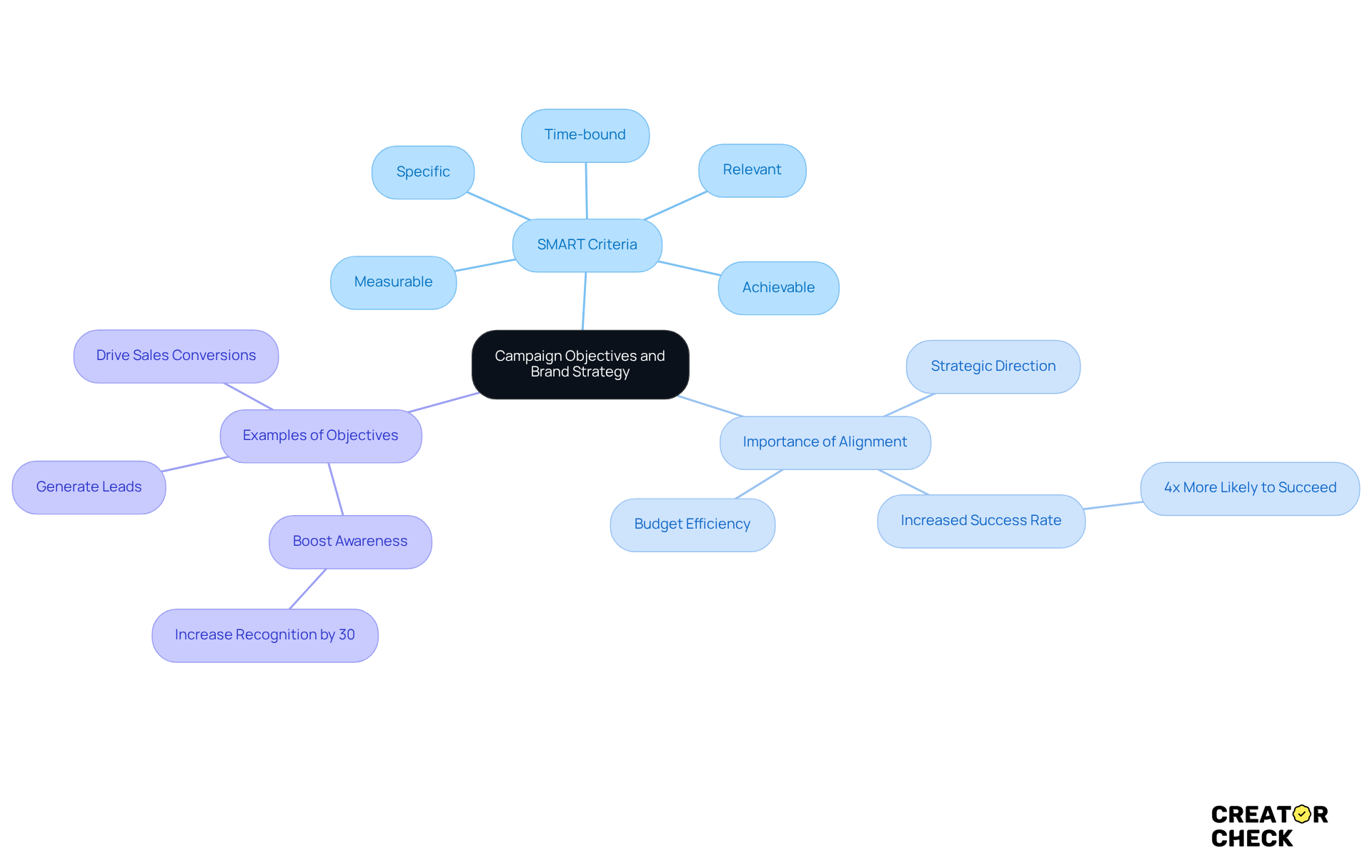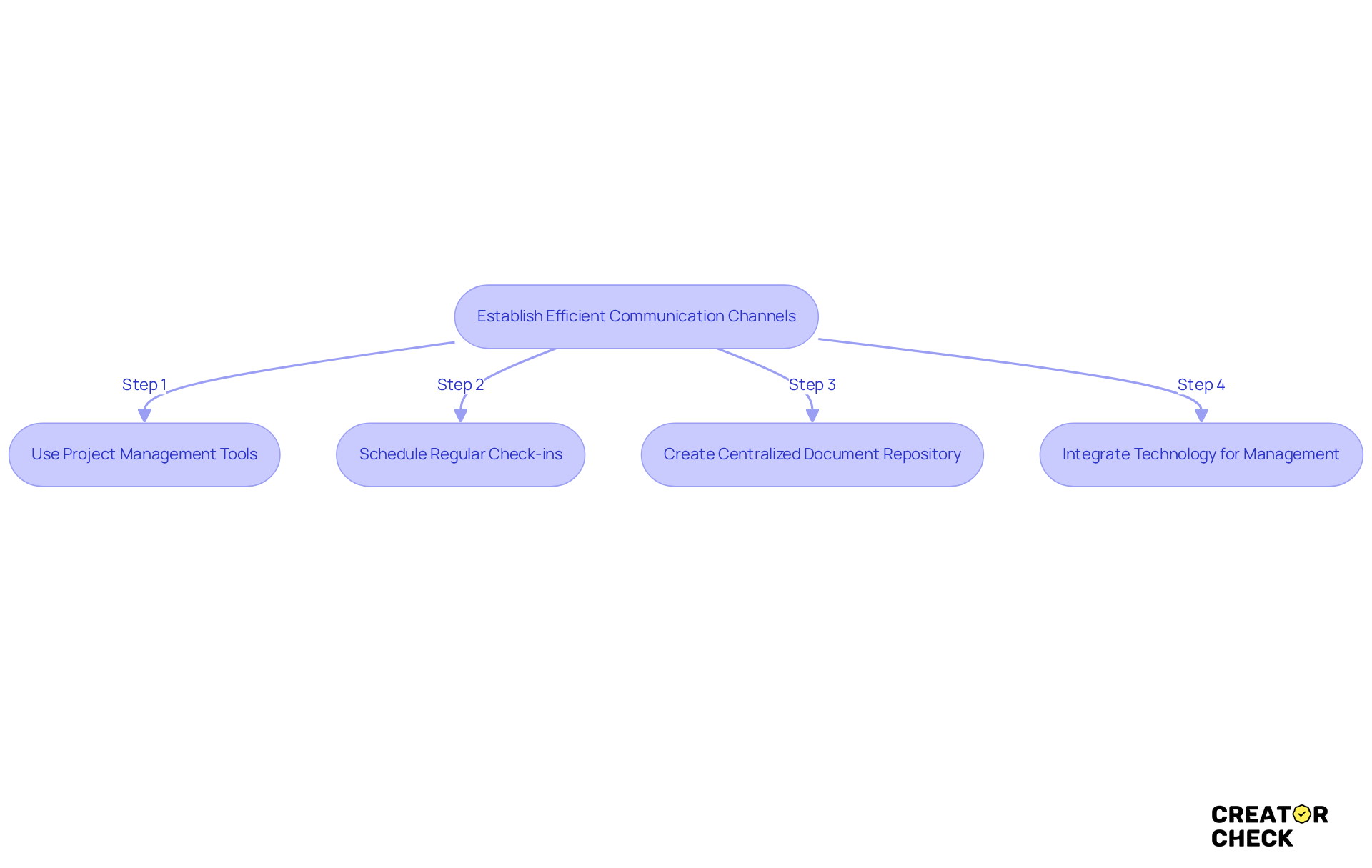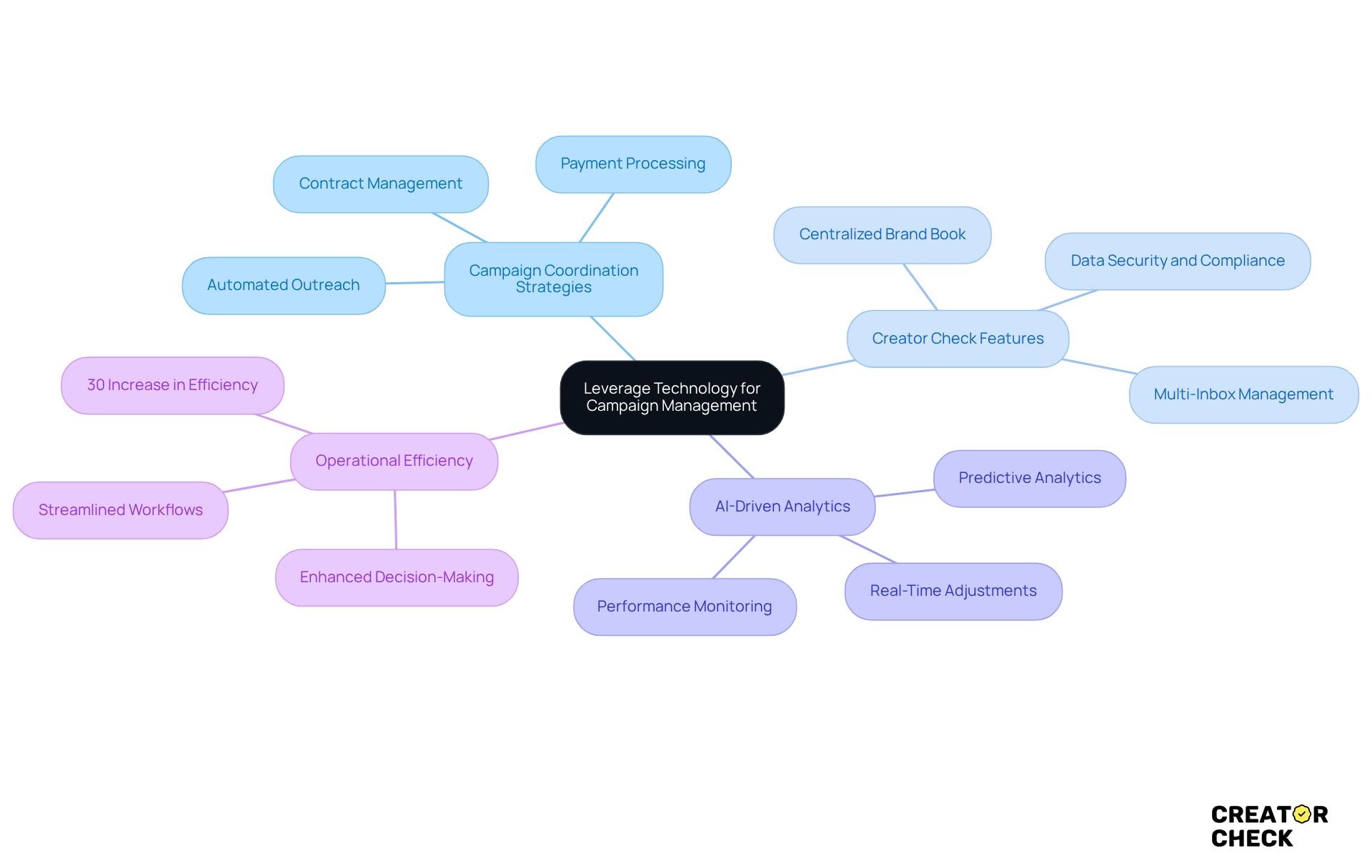Overview
This article shares four key strategies for coordinating campaigns within large influencer teams:
- Define clear campaign objectives.
- Select the right influencers.
- Establish efficient communication channels.
- Leverage technology for streamlined management.
These strategies are crucial because they help ensure alignment with brand goals, boost collaboration, and make the most of data-driven insights to optimize campaign performance. Ultimately, this leads to greater effectiveness and success in your influencer marketing initiatives. So, what does this mean for you? It’s all about making your campaigns run smoother and achieving those goals together!
Introduction
In the fast-changing world of influencer marketing, the success of big campaigns really depends on how well we coordinate strategies that match up with brand goals. By setting clear objectives, picking the right influencers, and using technology effectively, teams can work together better and achieve impressive results.
But with so many options and tools out there, how can marketers make sure they’re making the best choices for their campaigns?
Let’s dive into some key strategies for managing large influencer teams, offering insights that could change how brands tackle their marketing efforts.
Define Clear Campaign Objectives and Align with Brand Strategy
To effectively organize campaign coordination strategies for large influencer teams, it's super important to set clear goals that align with your company’s overall strategy. This process kicks off by identifying specific objectives—think about whether you want to boost awareness of your company, generate leads, or drive sales conversions. A great way to formulate these objectives is by using the SMART criteria (Specific, Measurable, Achievable, Relevant, Time-bound). For example, instead of saying something vague like 'enhance awareness of the company,' a clearer target would be 'boost recognition by 30% within three months through focused partnerships with key figures.' This kind of clarity not only helps focus the initiative but also makes it easier to assess its success later on.
Aligning these objectives with your marketing strategy ensures that everyone involved is contributing meaningfully towards a common goal, which can significantly enhance the effectiveness of your campaign coordination strategies for large influencer teams. Did you know that brands with clearly defined objectives are four times more likely to succeed in their marketing efforts? This really highlights how crucial strategic alignment is for achieving the outcomes you desire. So, what does this mean for you? It means that taking the time to set clear, actionable goals can make all the difference in your campaign’s success!

Select Influencers Based on Audience Targeting and Engagement Metrics
Choosing the right influencers for your initiatives is all about being strategic and focusing on audience demographics that match your target market. Have you ever thought about using analytics tools to uncover key audience traits like age, gender, location, and interests? It's super important to dig into engagement metrics too—things like likes, comments, shares, and overall interaction rates. For instance, a social media personality with a smaller but highly engaged following can often deliver better results than someone with a huge but less active audience. This targeted approach not only boosts the significance of your initiative but also builds genuine relationships between the promoter and their audience, leading to more impactful messaging.
So, what does this mean for you? Well, in 2025, the spotlight on engagement metrics is only going to get brighter, as brands recognize their role in driving success and nurturing deeper consumer relationships. With the marketing sector's key figures projected to reach $33 billion, picking the right personalities is more crucial than ever. Just look at successful initiatives like Hurom's impressive 2.5x increase in ROAS and Genomelink's 73% drop in CAC—they show the real benefits of focused marketing strategies involving key individuals. On the flip side, ignoring engagement metrics can lead to costly mistakes, as choosing the wrong influencers can waste valuable time and resources. So, keep this in mind as you navigate your influencer selection process!

Establish Efficient Communication Channels and Processes
To keep the creative juices flowing among large teams, it’s super important to set up efficient communication channels. Have you tried using project management tools like Slack, Trello, or Asana? They can create dedicated spaces for discussions, updates, and feedback, making collaboration a breeze. Don’t forget to schedule regular check-ins or meetings to review progress and tackle any challenges that pop up along the way.
And here’s a tip: having a centralized document repository for all your campaign materials, timelines, and guidelines is crucial. This structured approach not only keeps everyone in the loop but also fosters a collaborative vibe where insights and ideas can be freely shared. Research shows that organizations using project management tools see significantly better communication and project outcomes—64% of high-maturity projects are delivered on time!
So, what does this mean for you? By implementing campaign coordination strategies for large influencer teams, influencer marketing firms can significantly enhance their collaboration efforts, resulting in more successful campaigns. Plus, with Creator Check’s capabilities, agencies can manage multiple inboxes from different providers, search across all creator emails at once, and ensure compliance with GDPR standards. This means enhanced data privacy through enterprise-grade encryption.
This tech integration not only simplifies management but also ramps up revenue potential, letting teams focus on securing brand deals instead of sifting through endless emails. Isn’t that a win-win?

Leverage Technology for Streamlined Campaign Management
To really amp up your campaign management, it’s super important to utilize campaign coordination strategies for large influencer teams that automate the key parts of your marketing process. Platforms like Creator Check make it a breeze to manage influencer outreach, handle contract negotiations, and process payments—all while keeping your data secure and private. With enterprise-level encryption and full compliance with GDPR, Creator Check protects sensitive information, letting you focus on what truly matters.
And let’s not forget about the Brand Book feature! It provides a centralized spot for all your brand guidelines and assets, which is a game-changer. Plus, with AI-driven analytics tools, you can monitor the effectiveness of your campaign coordination strategies for large influencer teams in real-time. This means you can make quick adjustments based on data insights. For instance, companies that have embraced AI for predictive analytics have seen a whopping 30% boost in operational efficiency—talk about effectiveness!
So, if your engagement rates start to dip, you can adjust your campaign coordination strategies for large influencer teams mid-campaign to turn things around. Creator Check also shines in its ability to manage multiple inboxes from different providers and search through all creator emails at once. This not only saves you time but also helps you pick the right influencers more accurately. Centralizing creator data, as industry experts suggest, allows organizations to build on past successes and avoid repeating mistakes.
Integrating these technologies while balancing automation with a touch of human creativity empowers agencies to enhance operational efficiency and maximize their campaign coordination strategies for large influencer teams. In a competitive landscape, this approach ultimately drives better results. So, how are you planning to leverage these tools for your next campaign?

Conclusion
Establishing effective campaign coordination strategies for large influencer teams is essential for achieving marketing success. By defining clear objectives that align with brand strategies, selecting the right influencers based on audience engagement, fostering efficient communication, and leveraging technology, organizations can significantly enhance their influencer marketing efforts. These strategies not only streamline operations but also ensure that all team members are working towards a common goal, maximizing the overall impact of the campaign.
So, what’s the takeaway from this article? Key insights emphasize the importance of:
- Setting SMART goals
- Utilizing analytics for influencer selection
- Maintaining open communication channels
Integrating technological tools, like project management platforms and secure data handling systems, empowers teams to operate more efficiently while adapting to real-time data insights. As the influencer marketing landscape continues to evolve, these best practices become increasingly vital for driving successful outcomes.
In a competitive environment where brands are vying for consumer attention, adopting these campaign coordination strategies isn’t just beneficial; it’s imperative. By prioritizing strategic alignment, audience engagement, and innovative technology, organizations can enhance their campaign performance and build lasting relationships with their audience. The time to implement these practices is now—embracing them will pave the way for future successes in influencer marketing.
Frequently Asked Questions
Why is it important to define clear campaign objectives?
Defining clear campaign objectives is crucial because it helps focus the initiative and makes it easier to assess its success later on. Clear goals also ensure that everyone involved is working towards a common aim, significantly enhancing the effectiveness of campaign coordination strategies.
How can I formulate effective campaign objectives?
Effective campaign objectives can be formulated using the SMART criteria, which stands for Specific, Measurable, Achievable, Relevant, and Time-bound. For example, instead of a vague goal like 'enhance awareness of the company,' a clearer objective would be 'boost recognition by 30% within three months through focused partnerships with key figures.'
What is the relationship between campaign objectives and brand strategy?
Aligning campaign objectives with the overall brand strategy ensures that all efforts contribute meaningfully towards a common goal, which can significantly improve the effectiveness of the marketing campaign.
What impact do clearly defined objectives have on marketing success?
Brands with clearly defined objectives are four times more likely to succeed in their marketing efforts, highlighting the importance of strategic alignment in achieving desired outcomes.
What should I consider when setting campaign objectives?
When setting campaign objectives, consider whether your goals are aimed at boosting awareness, generating leads, or driving sales conversions, and ensure they align with your overall marketing strategy.




